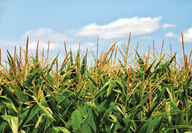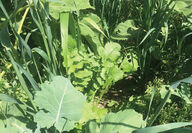Sorted by date Results 128 - 152 of 186

North Dakota State University Extension has updated the Crop Compare program, which is a spreadsheet designed to compare cropping alternatives. The program uses the direct costs and yields from the 2021 projected crop budgets for nine regions of North Dakota, but producers are encouraged to enter the expected yields and input costs for their farm. The user designates a reference crop and enters its expected market price. Depending on the region, a broad selection of nine to 18 crops are...

Irrigation provides more consistent crop production on a year-to-year basis, allows growth of longer-season crops, diversifies the farm enterprise and provides a consistent supply of forage for animal operations. "However, managing an irrigation system around variable rain events can sometimes be a challenge for busy farmers," says Tom Scherer, North Dakota State University Extension agricultural engineer. To provide producers with some assistance, NDSU Extension is holding a virtual irrigation...

The Oliver County 4-H range judging team placed first in the senior division of the North Dakota 4-H and FFA range judging contest at Center. Team members are Breanna Hosman, Hebron; Olivia Klein, Max, and Reanna Schmidt, Katie Frank, Breanna Vosberg and Rylee Hintz, Center. Hosman received the Head of the Herd Award as the top-scoring individual in the 4-H division. The Oliver County team is coached by Rick Schmidt. The team will represent North Dakota at the National Invitational 4-H Range...

North Dakota producers need to be vigilant about keeping Palmer amaranth, a particular noxious weed, off their land, according to North Dakota State University Extension specialists. This weed has been found in new North Dakota counties every year since 2018, and 2020 was no exception. One source of introduction in 2020 was through contaminated grain screenings. Samples pulled from a pile of sunflower screenings detected up to 1,000 Palmer amaranth seeds per pound of screenings from one source....
The Oliver County 4-H range judging team placed first in the senior division of the North Dakota 4-H and FFA range judging contest at Center. Team members are Breanna Hosman, Hebron; Olivia Klein, Max, and Reanna Schmidt, Katie Frank, Breanna Vosberg and Rylee Hintz, Center. Hosman received the Head of the Herd Award as the top-scoring individual in the 4-H division. The Oliver County team is coached by Rick Schmidt. The team will represent North Dakota at the National Invitational 4-H Range Judging Contest in Oklahoma in the spring of 2021....

Rainfall ranks as one of the most important factors that influence ranchers' management decisions, according to North Dakota State University Extension specialists. This year is no different. Parts of North Dakota are experiencing severe dry weather while others have adequate to plentiful moisture. This situation drives management of native pasture, crop residue and cover crop acres. Typically, even with good moisture at this time of the year, the nutritional value of native pasture is in declin...

Changes in federal grazing and harvesting rules on prevented-planting acres could help North Dakota livestock producers in select counties replenish forage supplies, or at least offset shortages in perennial forage production, according to North Dakota State University Extension livestock specialists. The U.S. Department of Agriculture (USDA) will allow producers to graze, hay or cut cover crops on prevented-planting acres beginning Sept. 1. Counties included in the change are: Barnes, Benson,...

The third in a four-part webinar series hosted by gerontologists from North Dakota State University Extension and South Dakota State University Extension will take place on August 14. It will discuss aging, how aging is different from disease, and barriers and strategies to aging well. The webinar begins at noon CDT. Most people think aging happens to someone in their 60s or 70s, when in fact, all adults are aging, says Jane Strommen, NDSU Extension gerontology specialist. While chronic disease...

North Dakota's drought-stressed pastures, especially pastures stressed during the fall of 2017, should receive special care this spring to help them recover from the drought, North Dakota State University Extension Service grazing experts advise. "It is critical that these pastures are given adequate time to recover," says Miranda Meehan, livestock environmental stewardship specialist. "Grazing too early in the spring can result in decreased total forage production for the entire grazing...

Pulse crop producers have a new tool to help them identify insect pests that attack chickpeas, field peas and lentils in the major pulse-growing areas of the U.S. The new "Pulse Crop Insect Diagnostic Series" from the North Dakota State University Extension Service summarizes insect pests of the northern Plains (Montana, North Dakota and South Dakota) and the Palouse area of the Pacific Northwest (Washington, Idaho and Oregon). The series was a collaborative effort among NDSU, University of...
Farmers, crop scouts, agronomists and other agricultural professionals will have an opportunity to enhance their pest identification and management skills at the North Dakota State University Extension Service’s 2018 Western Crop and Pest Management School. The school will be held March 6-7 at the Williston Area Recreation Center on the Williston State College campus. Participants also will be able to hear about current research results on topics such as weed control and pulse crop disease management. This is the first time the school has b...

Soil samples in North Dakota indicate low levels of overwintering wheat midge larvae (cocoons) for the 2018 season, according to Janet Knodel, North Dakota State University Extension Service entomologist. A total of 201 soil samples were collected from 21 counties in the fall of 2017 to estimate the regional risk for wheat midge in 2018. The distribution of wheat midge is based on unparasitized cocoons found in the soil samples. "Less than 1 percent of the soil samples had economic population...

Keeping stored grain cool is important as outdoor temperatures fluctuate and eventually start to warm this spring, a North Dakota State University Extension Service grain storage expert advises. "Not only will daytime temperatures be increasing, but the bin works as a solar collector," Extension agricultural engineer Ken Hellevang says. More heating occurs on the south wall of a grain bin on March 1 than during the middle of the summer. "This heats the grain next to the bin wall to temperatures...

Farmers, crop scouts, agronomists and other agricultural professionals will have an opportunity to enhance their pest identification and management skills at the North Dakota State University Extension Service's 2018 Western Crop and Pest Management School. The school will be held March 6-7 at the Williston Area Recreation Center on the Williston State College campus. Participants also will be able to hear about current research results on topics such as weed control and pulse crop disease...

Five Best of the Best in Wheat and Soybean Research and Marketing meetings have been set for Grand Forks, Moorhead, Minn., Dickinson, Williston and Minot. The first series of meetings will focus on recent issues that impact wheat and soybean production. They will be held at the Alerus Center in Grand Forks on Jan. 31 and at the Courtyard by Marriott Hotel in Moorhead on Feb. 1. Both meetings will begin at 8:30 a.m. Joel Ransom, NDSU Extension agronomist and one of the meeting organizers,...

Rural Leadership North Dakota's eighth class includes farmers, a rancher, farm assistance program representatives, business owners, city and county officials, health care and bank personnel, a consultant and communications specialists. They are among 26 people selected for the North Dakota State University Extension Service's leadership development program that started in November. They will spend 18 months developing skills to help them shape the future of their organization, community and...

Each year brings challenges for crop production, and this year's drought and cool August will have a big impact on North Dakota's corn production, North Dakota State University Extension Service grain drying expert Ken Hellevang warns. Much of eastern North Dakota is 100 to 200 growing degree-days behind normal, according to the North Dakota Agricultural Weather Network. This is reflected in the National Agricultural Statistics Service crop production report showing that on Oct. 1, only 47 perce...

Six years ago, about the time Vawnita Best gave up a 15-year career involving extensive travel to stay at home to raise her then-2-year-old son and help her husband build their registered Angus herd, she was accepted into the North Dakota State University Extension Service's Rural Leadership North Dakota program. "I was excited to find a leadership program structured for people with a passion for North Dakota, agriculture and community," the Watford City rancher says. The 18-month leadership...

Anthrax could be a risk to livestock in North Dakota this year, North Dakota State University Extension Service veterinarian Gerald Stokka warns. Very dry conditions, which North Dakota experienced this year, or high rainfall can cause it to be a health issue. "Anthrax is a disease caused by a bacteria known as Bacillus anthracis," Stokka says. "This bacteria has a special survival mechanism called spore formation. This characteristic allows the bacteria to produce spores with a very hardy,...
To maintain the North Dakota 4-H program in the face of budget cuts, 4-H will implement a $20-per-year state-level program fee for participation. The fee helps fill the gap left by declining state funding, according to Brad Cogdill, chair of the North Dakota State University Extension Service’s Center for 4-H Youth Development. The decision to implement the fee came after a $4.1 million reduction in state funding for the Extension Service for the current biennium and a recommendation from an ad hoc committee the State Board of Agricultural Rese...
Stored grain needs to be cool and dry during summer storage, a North Dakota State University Extension Service grain-drying expert says. “Cold or cool grain has been safely stored through the summer for many years,” notes Ken Hellevang, an Extension agricultural engineer. “Keeping the grain as cool as possible should be the goal of summer grain storage.” Allowing grain to warm to average outdoor air temperatures during the summer can lead to insect infestations and mold growth. The optimum grain temperature for insect activity is approxi...

The North Dakota State University Williston Research Extension Center (WREC) will showcase dryland agronomy and horticulture at its annual field day on July 13 and host an irrigation field day on July 14. The July 13 event begins with coffee and rolls at 8:30 a.m. CDT. The dryland crops tour starts at 9 a.m. Topics to be highlighted during the dryland crop tour are: * Durum wheat breeding and genetics * Foundation seed increase program overview * Interseeding demonstration plots * Northern...

Yellow patches of leafy spurge are beginning to pop up in road ditches across North Dakota. "Leafy spurge is the most recognized noxious weed in the state, infesting approximately 746,183 acres, followed by Canada thistle (824,659 acres) and absinth wormwood (608,414 acres)," says Miranda Meehan, North Dakota State University Extension Service livestock environmental stewardship specialist. "These species are the most common noxious weeds found on rangeland and pastures across the state."...

Using estrus synchronization and artificial insemination to control breeding in cattle has several benefits, according to North Dakota State University livestock experts. "Artificial insemination (AI) offers the opportunity to use semen from high-accuracy, genetically superior sires at a fraction of the cost of purchasing a herd bull of similar genetics," says NDSU Extension Service beef cattle specialist Carl Dahlen. "In addition, using estrus synchronization and AI can increase the number of...

A cow herd's nutrient requirements are greatest from immediately after calving through peak milk production. "Inadequate nutrition during this time may have immediate impacts in terms of lower calf birth weights, weak calves and/or increased death loss, and decreased milk production," says Janna Kincheloe, the North Dakota State University Extension Service's area livestock systems specialist at the Hettinger Research Extension Center. "However, the consequences of low body condition at calving...